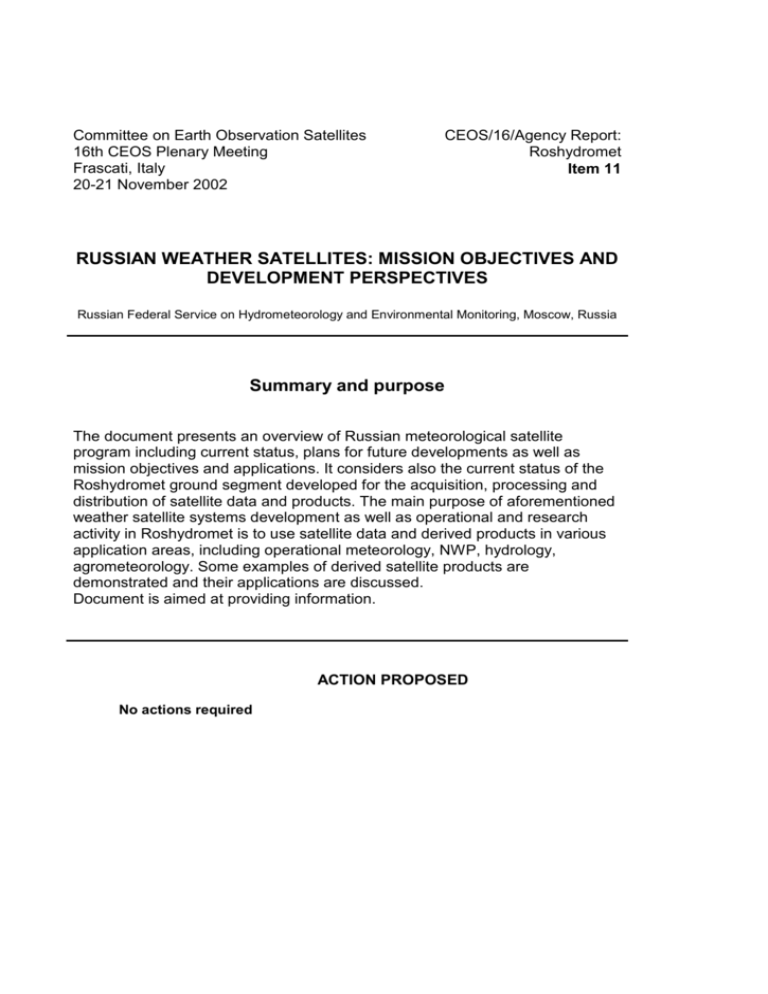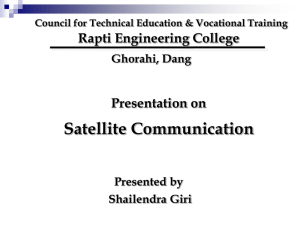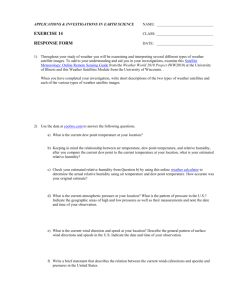THE TECHNIQUE TO DERIVE THE SURFACE TEMPERATURE
advertisement

Committee on Earth Observation Satellites 16th CEOS Plenary Meeting Frascati, Italy 20-21 November 2002 CEOS/16/Agency Report: Roshydromet Item 11 RUSSIAN WEATHER SATELLITES: MISSION OBJECTIVES AND DEVELOPMENT PERSPECTIVES Russian Federal Service on Hydrometeorology and Environmental Monitoring, Moscow, Russia Summary and purpose The document presents an overview of Russian meteorological satellite program including current status, plans for future developments as well as mission objectives and applications. It considers also the current status of the Roshydromet ground segment developed for the acquisition, processing and distribution of satellite data and products. The main purpose of aforementioned weather satellite systems development as well as operational and research activity in Roshydromet is to use satellite data and derived products in various application areas, including operational meteorology, NWP, hydrology, agrometeorology. Some examples of derived satellite products are demonstrated and their applications are discussed. Document is aimed at providing information. ACTION PROPOSED No actions required 2 RUSSIAN WEATHER SATELLITES: MISSION OBJECTIVES AND DEVELOPMENT PERSPECTIVES ** Russian Federal Service on Hydrometeorology and Environmental Monitoring, Moscow, Russia INTRODUCTION The document presents an overview of Russian meteorological satellite program including current status, plans for future developments as well as mission objectives and applications. Along with the exploitation of current satellites by Roshydromet the efforts are continuing on the serious modernization of national weather satellite system consisting of two components: the polar orbiting satellites of Meteor-3M series and the geostationary satellite ELECTRO. The first polar orbiting satellite METEOR-3M N 1 of next generation of meteorological satellites has been successfully launched in December 2001. The next satellite of Meteor-3M series should be launched not later than 2005 The short description of METEOR-3M core meteorological payload is given together with some results of Meteor 3M N 1 commissioning phase and examples of operational products. The next geostationary satellite ELECTRO N 2 is expected to be launched in 2005 and placed into orbit at 760 E. The ELECTRO N 2 spacecraft will rely on 3-axis stabilized platform carrying the imager of VIS and IR range and meteorological communication package (the DCS). Some performance characteristics of this basic instrument are shortly discussed. The document considers also the current status of the Roshydromet ground segment developed for the acquisition, processing and distribution of satellite data and products. The main purpose of aforementioned weather satellite systems development as well as operational and research activity in Roshydromet is to use satellite data and derived products in various application areas, including operational meteorology, NWP, hydrology, agrometeorology. Some examples of derived satellite products are demonstrated and their applications are discussed. 2. METEOR-3M MISSION AND SPACE SEGMENT DEVELOPMENT Russia is now developing next series polar orbiting meteorological satellites, METEOR-3M. The first polar orbiting satellite METEOR-3M N 1 of this series has been successfully launched in December 2001. The table 1 summarizes the instruments embarked on board this spacecraft. The next satellite of Meteor-3M series that should be launched not later than 2005 is designed for operational providing of hydrometeorological and heliogeophysical information. The primary mission objectives of existing and forthcoming METEOR 3M satellites are quite similar to those specified for NOAA and EPS/METOP satellites (see e.g. Buhler et al., 2001) and include: atmospheric temperature & humidity soundings for NWP support (global and regional coverage) imagery of clouds and land/ocean surfaces (global and regional coverage) ozone and other trace species monitoring sea ice and snow coverage monitoring support of climate monitoring 3 providing heliogeophysical information data collection and location In order to fulfil these mission objectives and to meet the requirements of the users (mainly in the field of operational meteorology and climate monitoring), the basic characteristics of the spacecraft including payload and their principal manufacturer have been specified in 2001 through the tender organized by Russian Aviation and Space Agency (Rosaviacosmos) together with Roshydromet and other Russian State departments (see e.g.Dyaduchenko et al., 2001; CGMS, 2001). The Meteor-3M spacecrafts being launched on sun-synchronized orbit will carry as mandatory payload the imagers of visible (VIS), infrared (IR) and microwave (MW) range as well as IR and MW atmospheric sounders. In summer 2002 the original satellite sketching design was rather seriously revised. It is proposed to develop and to launch in the years 2005 and 2007 two satellites on the base of unified and rather heavy platform (of «Resurs» type) with a suite of experimental and operational instruments. Both these satellites that should provide the flight demonstrations of key systems will be predecessors of operational and complete METEOR-3M satellite. Moreover both new spacecrafts will be equipped with supplementary instruments. In particular, it is planned to develop and install the locator (radar) “Severjanin” and multichannel optical scanning device KMSS of medium resolution ( 100 m) on board the first new satellite. The implementation of these instruments should ensure substantial extension of METEOR-3M mission objectives. The final characteristics of above both satellites will be specified before the end of 2002. Below a brief overview of basic METEOR-3M instruments for the main missions is presented. METEOR-3M sounding capabilities The payload composition of METEOR-3M satellites should consist of the suite of sounding instruments providing remote sensing of three-dimensional fields of temperature and humidity of the atmosphere. METEOR-3M MW sounder/imager MTVZA One of the major sensors of this suite is multichannel microwave (MW) conical scanning radiometer MTVZA. The primary mission of MTVZA measurements that is similar to NOAA/AMSU instrument is to provide all-weather atmosphere temperature and humidity sounding capabilities to support numerical weather prediction (nwp) schemes of global and regional coverage. The MW radiometer MTVZA, being designed and manufactured by the Space Observations Center, Rosaviakosmos is based on the technology of combining in space and time the multi-spectral and polarization measurements, see fig 1. The MTVZA operating frequencies are located both in the transparent bands of 18.7, 33, 36.5, 42, 48, 91.61 GHz as well as in absorbing lines of oxygen 52-56 GHz and water vapor 22.235 and 183,31 GHz, see table 2. The important feature of instrument is that it provides the common field of view for imaging and sounding channels. The general description of MTVZA prototype instrument can be found in (Cherny & Raiser, 1998), (Uspensky at al., 1999). Here we give some details concerning MTVZA observation geometry and calibration technique. The MTVZA rotates continuously about an axis parallel to the local spacecraft vertical with a period of 2.5 s during which the subsatellite point, moving at 6.32 km/s, travels 15.8 km. The instrument is a conical scanning device and it looks backward. The viewing angle is 53.5 and the incidence angle with respect to the Earth surface - 69. The sampling resolution is 17.8x15.8 km in the cross-track and along-track direction respectively for channels of 91.6 GHz, 35.6x31.6 km for channels of 18.7-48 GHz, and 71.2x63.2 km for channels of 52-57 and 183 GHz. The scan direction is from the left to the right when looking in the aft direction of the spacecraft, with the active scene measurements lying from 60 to +27 about the aft direction, resulting in a swath width of 2200 km, see fig 5 in (Uspensky et al., 1999) 4 For calibration the hot and cold reference absorbers are used. They are mounted on the nonrotating part of instrument and are positioned such that they pass between the feed-horn and flat mirror, occulting the feed-horn once each scan. The temperature difference between hot and cold target is equal to 50-60 K. The spacecraft operation testing result for hot and cold target is in a good agreement with the calibration results obtained during ground thermal/vacuum testing. The notable changes in the MTVZA instrument deployed on board METEOR-3M N 1 spacecraft consist of the following (Uspensky et al., 2001): the channels 22-26 (see Table 2) with maximum of the weighting functions at high troposphere and low stratosphere levels are eliminated; these channels sensing the stratosphere temperature will be restored for the enhanced follow-on MTVZA instruments, namely MW radiometer intended for METEOR-3M N 2. The continuous on-board recording of the global data set is performed, although these data are dumped only twice a day (not every orbit) at a dedicated ground station (in Moscow region) due to the experimental status of the first MTVZA instrument. It is planned to design standard HRPT downlink (L-band, 1.7 GHz) for METEOR-3M N 2 spacecraft in order to support direct broadcast of MTVZA data to the users community. At the middle of February this year the performance tests of MTVZA instrument have started in the framework of METEOR-3M N 1 commissioning phase. Real performance characteristics of flying MTVZA instrument are summarized in table 3. The first results of testing are promising: the instrument designers have succeeded in the preprocessing of raw MTVZA data and forming the imageries corresponding different channels. The examples of global imageries at frequency 33 GHz (scanner’s transparent channel 5, horizontal polarization) as well as at frequency 55,65 GHz (sounding channel 16) and at frequency 52,8 (sounding channel 12) are presented at fig 2, 3. The imagery in “transparent” channel 5 provides reliable identification of continents and ocean surfaces as well as some meteorological features. Fig 4 demonstrate the fragments of global imageries in channel 5 illustrating the dynamics of cloud structures over the South Atlantics. Now the work is underway on the adjustment of preprocessing software package as well as on the completing and trials of the absolute calibration procedure. METEOR-3M advanced IR sounder IRFS-2 During last 8 years the team led by Keldysh Research Center, Rosaviakosmos, has been engaged in the design and fabrication of multi-purpose Fourier transform spectrometer. One such instrument called IRFS was planned to be installed on board METEOR-3M №2 (Uspensky et al., 1999). To meet requirements induced by METEOR-3M N 2 spacecraft performance figures as well as to reduce budget expences some notable changes have been made in the original design of IRFS (Uspensky et al., 1999). Below the short description of new instrument design (named IRFS-2) is outlined following (Zavelevich et al., 2002). The IRFS-2 instrument assembly includes optical unit, data processing and power supply system and radiative cooler. The optical unit is separated into several modules: interferometric module (IM), pointing module, calibration module. IM includes interferometer of double pendulum type and radiometer. Comparing with original design, the short wave channel (2-4.5 m) has been eliminated. The basic performance characteristics of IRFS-2 are given in the table 4. As it is seen from the table, the operable spectral range extends from 5 to 15 m. Inside this range the measurements in spectral regions presented in the table 5 provide information useful for generation of various sounding products, similar to those from (Chalon et al., 2001). The experiments with the prototype of IRFS-2 demonstrate the feasibility of proposed scheme and main modules (Zavelevich et al., 2002). 5 To conclude this subsection note that along with described atmospheric sounders the development of the supplementary sounding instrument called Radiomet and based on radio occultation principles is now under consideration. The evident advantages of such instruments are the low cost and mass. METEOR-3M imaging capabilities Besides atmospheric sounding the payload composition of METEOR-3M satellites should consist of the suite of imaging instruments providing imagery of clouds and land/ocean surfaces. The major sensor of this suite is optical radiometer MSU-MR (so called Globus). This instrument has 6 channels in VIS/IR and is cross-track scanning radiometer with basic characteristics similar to those for NOAA/AVHRR/3. The multichannel scanning unit (named KMSS) is proposed as supplementary imaging instrument. This device should provide the imagery in 4 VIS channels (0.45-0.9 m) of medium resolution (100 m). The imaging mission in MW should be fulfilled by MTVZA instrument. Also now is actively discussed the optional replacement on-board of the next METEOR-3M satellite the MW sounder-imager MTVZA by modified sensor MTVZA-OK (Uspensky et al., 2001) providing the measurements in MW and optical (VIS/IR) channels. Imaging mission will be also performed by supplementary “active” sensor i.e. radar (so called “Severjanin”). This instrument is now under development. Its operating frequency range is 9500-9700 MHz, the swath band is about 450 km with two modes of spatial resolution i.e. minimum or low (0.7 x 1.0 km) and optimum or medium (0.4 x 0.5 km) These characteristics will be précised. 3. FUTURE GEOSTATIONARY METEOROLOGICAL SATELLITE GOMS/Electro N 2 In 2001 Rosaviakosmos together with Roshydromet and other Russian State departments committed a tender on development of future GOMS/Electro geostationary meteorological satellite that will meet requirements of national and international users community. As a result of the tender the satellite manufacturer has been selected and principal characteristics of spacecraft and its payload have been specified. GOMS/Electro N 2 satellite being relied on 3-axis stabilized platform will be designed to allow operational observation of cloudiness and Earth surface, conducting heliogeophisical measurements and maintaining Russian Data Collection System. The satellite main instrumental payload is the optical imaging (line-by-line scanning) radiometer so called MSU-G. It should provide image data in three visible and near IR channels (VNIR) and 7 IR channels. Spectral characteristics of channels are presented at table 6. The spatial resolution in subsatellite point will be about 1 km for VNIR and 4 km for IR channels, i.e. the VNIR and IR channels scan the Earth with 1 km and 4 km sampling distance respectively. A new earth image will be provided every 30 min. Along with this the more frequent regime is envisaged (every 10-15 min) for selected image fragments and channels are foreseen in MSU-G instrument. In the framework of design finalization it is planned to investigate the possibilities to implement supplementary channels 11, 12. It is worth noting that providing accurate on-board calibration for IR and solar channels (which is envisaged in the sketch design) remains an issue. Another issue is ensuring about 10 years of nominal lifetime for the spacecraft and its basing systems (including MSU-G) In case of successful solution of listed problems the MSU-G instrument with full ensemble of 12 channels should provide the information similar to that of MSG/SEVIRI. 6 The second important mission objective of GOMS/Electro N 2 is the development and maintaining of national data collection system (DCS). According to current planning it should be developed the DCS capable to operate with about 800 national DCP platforms. To conclude brief overview of GOMS/Electro N 2 design, note that in addition to serving primary meteorological missions, GOMS/Electro N 2 will be also equipped with a transponder for the geostationary Search & Rescue service of the COSPAS/SARSAT organization. Similar to Meteosat, MSG this payload should be implemented subject to some constraints, namely, no interference with the meteorological missions and minimum mass. 4. STATUS OF ROSHYDROMET CORE GROUND SEGMENT, SATELLITE PRODUCTS AND APPLICATIONS The description of Roshydromet ground segment developed for operation with the satellite meteorological systems is given in (Bedritsky et al., 1999). The major components of the Roshydromet ground segment are three Main Regional satellite data receiving and processing Centres at different locations: in Moscow, Novosibirsk and Khabarovsk cities. The radiovisibility circles of these Centres cover the whole territory of Russia and Baltic States and major part of Europe. These Regional Centres are equipped with receiving and transmitting systems supporting the different missions and serving many satellite systems. Their facilities now allow, in particular, receiving high rate data from Resurs, OKEAN, SPOT satellites and in the future will allow handling the data streams of high density up to 256 Mbits/s. Under the authority of the Roshydromet main satellite center PLANETA (Moscow) there are the services for survey, planning and satellites control. The communication facilities of “Planeta” created on the basis of widespread network of various communication channels (including a link through the satellite, WWW technology via INTERNET) enable a reliable and operational transmission the information to the users and facilitate the data real-time access (including INTERNET). The architecture of future METEOR-3M and GOMS-Electro ground segments (hardware, software, communication links) is envisaged to be based on the physical facilities of Roshydromet ground segment major components described just above. Now the technical design and development of METEOR-3M and GOMS-Electro N 2 ground segments have been commenced. Some elements of future METEOR-3M ground segment have been tested in the framework of METEOR-3M N 1 commissioning phase. Very briefly about METEOR-3M N 1 products and applications. Some results of MTVZA instrument testing have been demonstrated in section 1. Examples of KLIMAT, MR2000M1 and MSU-E imagery based products are demonstrated below. Fig 5 illustrates the application of KLIMAT IR imagery for ice cover monitoring in Arctic (Northern Sea Route). The MR2000M1 imagery of Antarctic ice cover is presented at fig 6. The examples of utilization the MSUE high resolution images for forest fires, smokes and burnings defection as well as for river’s ice conditions and floods monitoring are demonstrated at fig 7-10. The authors wish to express their gratitude to all persons who contributed to this paper, in particular, to the persons at Rosaviakosmos Space Observation Center (G.M.Chernjavsky, I.V.Cherny) and at Keldysh Research Center (F.S.Zavelevich). References 1. Bedritsky A.I., Asmus V.V., Uspensky A.B. 1999. Current and future Russian 7 meteorological satellite systems and their application. Proc. of the 1999 Eumetsat Meteor. Sat. Data User’s Conf. 2. Buhler Y., Cohen M., Mason G. et al. 2001. The Eumetsat polar System: mission, system and programmatic. Proc. the 2001 Eumetsat Meteorol. Sat. Data User’s Conf. Antalya, Turkey, 1-5 0ct. 2001, EUM P 33, pp. 13-22 3. Chalon G. et al. 2001. IASI: an Advanced Sounder for operational Meteorology Intern. Astronaut. Federation. Toulouse Oct. 2001. 4. Cherny I.V., Raizer V.Yu. 1998. Passive Microwave Remote Sensing of Oceans. Wiley-Praxis, Chichester, p.195. 5. Dyaduchenko V.N., Asmus V.V., Uspensky A.B. 2001. Satellite products and their use in Roshydromet: Status and program overview. The 2001 Eumetsat Meteor. Data User’s Conf. Antalya, Turkey, 1-5 Oct. 2001, EUM P 33, pp 33-41. 6. Report of the 29th Meeting of the Coordination Group for Meteorological Satellites, 2001. CGMS-XXIX, 24-28 October 2001, Capri, Italy. 7. Uspensky A.B. et al. 1999. Sounding instruments for future Russian meteorological satellites. Tech. Proc. 10-th Int. TOVS Study Conf., Boulder, Co, 27.01-02.02 1999, pp.533-543. 8. Uspensky A.B., I.V. Cherny, G.M. Chernjavsky. 2001 Microwave sounding instruments for future Russian meteorological satellites. Tech. Proc. 11th Intern. ATOVS Study Conf. Budapest, Hungary, 20-26.09.2000, pp 399-405. 9. Zavelevich F.S., Yu.M.Golovin, Yu.P.Matsitsky et al. 2002. Space-borne Fourier Transform Spectrometer for the atmosphere temperature and humidity sounding. Submitted to the 3rd Intern. Conference on Mini satellites, Korolev, Russia, 27.05-31.05 2002. 8 Table 1 Instruments payload of the METEOR-3M N 1 Instrument / Application Spectral Band mass (kg) Swathwidth (km) Resolution (km) Cloud cover mapping 0.5 - 0.8 m 3100 0.7 x 1.4 Global and regional cloud cover mapping, SST 10.5 – 12.5 m 3100 3x3 Total humidity of the atmosphere 20.0-94.0 GHz 1500 80 – 40 MTVZA Atmospheric temperature 18.7-183.3 GHz 2600 12 – 75 100 imager/ and humidity profiles (20 channels) Multispectral images of high spatial resolution 0.5 – 0.6 m 76 within FOV of 430 38 m - 1 - 2 (vertical) MR-2000M1 46.6 KLIMAT 82.5 MIVZA (5 channels) sounder MSU-E 29 0.6 – 0.7 m 0.8 - 0.9 m Profiles of aerosols ozone, NO2, and other small atmospheric gazes 0.29 - 1.55 m SFM-2 03 vertical distribution UV band KGI-4C Heliogeophysics SAGE III 88 0.1 keV – Space environment 90 MeV Monitoring (protons, electrons, alpha particles, (11 channels) ions fluxes) MSGI-5EI (9 channels) Heliogeophysics Space environment monitoring (geo-active irradiances) 9 Table 2. MTVZA Microwave Frequency Channel Characteristics Channel Center No. of Band-width No. Frequency (GHz) pass (MHz) Polarization Approximate peak sensitivity V/H altitude (km) bands 1, 2 18.7 1 800 V, H - 3 22.235 1 1600 V - 4, 5 33.0 1 2000 V, H - 6, 7 36.5 1 2000 V, H - 8, 9 42.0 1 2000 V, H - 10, 11 48.0 1 2000 V, H - 12 52.80 1 400 V 2 13 53.30 1 400 V 4 14 53.80 1 400 V 6 15 54.64 1 400 V 10 16 55.63 1 400 V 14 17, 18 91.65 2 3000 V surface 19 183.31 ± 7.0 2 1500 V 1.5 20 183.31 ± 3.0 2 1000 V 2.9 21 183.31 ± 1.0 2 500 V 5.3 22 57.290344±0.3222±0.1 4 50 H 20 23 57.290344±0.3222±0.05 4 20 H 25 24 57.290344±0.3222±0.025 4 10 H 29 25 57.290344±0.3222±0.01 4 5 H 35 26 57.290344±0.3222±0.005 4 3 H 42 Channels 22-26 will be deployed in next version MTVZA of spacecraft "Meteor-3M" No.2. Table 3. 10 MTVZA Performance Characteristics Frequency (GHz) 18.7 22.2 33.0 36.5 42.0 48.0 52-57 91.6 183 45x82 41x75 36x65 32x58 30x55 18x33 12x22 71.2x 17.8x 71.2x 63.2 15.8 63.2 IFOV 75x136 68x124 (kmxkm) Imagery pixel 35.6x31.6 (kmxkm) Sensitivity (K/pixel) 0.25 0.25 0.35 0.38 0.45 0.45 0.3 0.5 0.4 0.5 0.5 0.6 0.6 0.7 0.7 1.0 1.0 1.1 93.7 93.4 93.5 93.5 92.8 93.9 94.2 95 95 -24 -24 -25 -24 -20 -23 -25 -24 -25 Calibration Accuracy, K (Ta=300 K) Antenna Beam Efficiency, % Cross-Polarization Isolation, dB Conical Scanning Period (ms) 2500.00.8 Viewing Angle (deg.) 53.5 Incident Angle (deg.) 69 Swath (km) Width 2200 Mass (kg) 107 Power 110 Consumed (W) Table 4 Basic performance characteristics of IRFS-2 11 № 1 Parameter Spectral range: wavelength wave number Units Value m 5-15 cm-1 200 0-665 2 Reference channel wavelength m 1.06 3 Maximum optical path difference (OPD) mm 17 4 Angular size of FOV mrad 40 x 40 5 Spatial resolution (at subsatellite point) km 35 6 Swath Width and spatial sampling km 2500, 110 2000, 100 7 Aperture angle of beams reaching the detector degree 63 8 Duration of the interferogram measurement s 0.5 9 Dynamic range 216 10 Number of reference points in two-sided interferogram 215 11 Frequency band of measuring channel kHz 4.5-13.5 12 Reference signal frequency kHz 65.5 13 Frequency band of reference channel kHz 61-70 14 Weight kg 45-50 15 Power W 50 Table 5 Spectral regions used by the IRFS-2 instrument nn Spectral region Absorption band Application 12 1 665 to 780 cm-1 CO2 Temperature profile 2 790 to 980 cm-1 Atmospheric window Surface parameters (Ts, ) Cloud properties 3 4 1000 to 1070 cm-1 O3 Ozone sounding 1080 to 1150 cm-1 Atmospheric window Ts, , Cloud properties 1210 to 1650 cm-1 5 H2O, N2O, CH4 Moisture profile, CH4, N2O column amounts Table 6. Geostationary meteorological satellite GOMS/Electro N 2 payload MSU-G spectral channel characteristics NN Channel Spectral range S/N for VIS NEDT for IR 1 Vis 0.6 0.5 - 0.65 10 2 Vis 0.7 0.65 - 0.8 10 3 Vis 0.8 0.8 - 0.9 7 4 IR 3.7 3.5 - 4.01 0.35 K 5 IR 6.7 5.7 - 7.0 0.75 K 6 IR 8.0 7.5 - 8.5 0.28 K 7 IR 8.7 8.2 - 9.2 0.28 K 8 IR 9.7 9.2 - 10.2 1.5 K 9 IR 10.7 10.2 - 11.2 0.3 K 10 IR 11.7 11.2 – 12.5 0.3 K 11* Vis 1.6 3 12* IR 13.4 1.8 K 13 14 15 16








